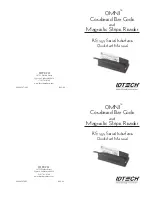
User’s Guide DIGI9636
© RME
14
If several digital devices are to be used simultaneously in a system, they not only have to
operate with the same sample frequency but also be synchronous with each other. This is why
digital systems always need a single device defined as ‘master’, which sends the same clock
signal to all the other (‘slave’) devices. RME’s exclusive
SyncCheck
technology, first
implemented in the Hammerfall, enables an easy to use check and display of the current clock
status. The ‘SyncCheck’ field indicates whether no signal (‘No Lock’), a valid signal (‘Lock’) or a
valid
and
synchronous signal (‘Sync’) is present at each of the three ADAT optical inputs. The
‘Sync Ref’ display shows the current sync source’s input and frequency.
In practice, SyncCheck provides the user with an easy way of checking whether all digital
devices connected to the system are properly configured. With SyncCheck, finally anyone can
master this common source of error, previously one of the most complex issues in the digital
studio world.
An example to illustrate this: The ADAT1 input is receiving a signal from a digital mixing desk
that has been set to clock mode 'Internal' or 'Master'. An ADAT recorder is connected to the
ADAT2 input. The
DIGI9636
is set to AutoSync mode. SyncCheck will now show that
ADAT1 and ADAT2 inputs are no in sync, the display shows ‘Lock’ instead of 'Sync' for the
ADAT2 input. Because the ADAT recorder is not receiving any signal from
Hammerfall
or
from the mixer, it will
generate its own clock at
a rate which is (almost)
the same as the sample
frequency of the mixing
desk - but not identical.
Remedy: To drive the
ADAT recorder from its
digital input, set it to
slave mode (DIG), and
connect the input to the
Hammerfall’s ADAT2
output.
DIGI9636
is
already in sync with the
mixing desk, so it will
send an identical
(synchronous) signal to
ADAT2 out. The ADAT recorder will lock onto this, its output will also be in sync. The signal
from the ADAT recorder is now fully in sync with the signals from the mixing desk.
Thanks to its AutoSync technique and a lightning fast PLL, the
DIGI9636
is not only
capable of handling standard frequencies, but also any sample rate between 25 and 105 kHz.
The input selected in 'Pref Sync Ref' serves as synchronization source. If the Expansion Board
has been installed, and the word clock input is selected (clock mode 'Word Clock'), this will
serve as the synchronization source, allowing any sample frequency between 25 kHz and 56
kHz in varispeed operation.
The current sample frequency at the S/PDIF input (displayed in the ‘SPDIF In’ field) is useful
for troubleshooting and checking the configuration of all connected digital devices. If an input
without a valid signal (or a faulty one) is selected, ‘No Lock’ will appear. In varispeed mode, or
if the sample frequency is way out of tune, ‘Lock’ is displayed.
At 88.2 or 96 kHz: If one of the ADAT inputs has been selected in ‘Pref Sync Ref’, the sample
frequency shown in the ‘SPDIF In’ field differs from the one shown in ‘Sync Ref’. The card
automatically switches to its Sample Split mode here, because ADAT optical inputs and outputs
are only specified up to 48 kHz. Data from/to a single input/output is spread over two channels,
the internal frequency stays at 44.1 or 48 kHz. In such cases, the ADAT sample frequency is
only half the SPDIF frequency.














































